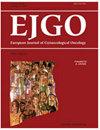Identification of hypoxia-related prognostic signature for ovarian cancer based on Cox regression model
IF 0.5
4区 医学
Q4 OBSTETRICS & GYNECOLOGY
引用次数: 2
Abstract
Objective : The purpose of this study is to establish a good prognostic risk assessment model of hypoxia genes to evaluate the 3-year and 5-year survival rates of patients with high-grade serous ovarian cancer. Methods : We performed differential analysis of hypoxia genes in the GSE26712 data set. The differential genes were then, analyzed in the TCGA ovarian cancer data set for risk regression analysis and verified in the GSE26712 data set. In addition, we performed a functional enrichment analysis on the genes in the signature of hypoxia, and further analyzed the level of hypoxia risk and immune infiltration. Finally, a nomogram combining the hypoxia risk score, clinical stage, pathological grade, 3-year and 5-year survival rate was constructed. Results : A signature containing 12 hypoxia-related genes was identified as a Cox regression model for predicting the prognosis of ovarian cancer, and verified it in an independent data set. Subsequent enrichment analysis revealed that the signature is related to the immune system. We have also demonstrated a significant relationship between the signature of hypoxia and the infiltration of certain immune cells. Finally, the nomogram shows the accuracy of hypoxia characteristics in predicting ovarian cancer prognosis. Conclusion : We have established a good prognostic risk assessment model for ovarian cancer related to hypoxia risk, which provides personalized survival predictions and possible targeted treatment strategies.基于Cox回归模型的卵巢癌症低氧血症相关预后标志的识别
目的:本研究旨在建立一个良好的缺氧基因预后风险评估模型,评估高级别浆液性卵巢癌患者的3年和5年生存率。方法:我们对GSE26712数据集中的缺氧基因进行了差异分析。将差异基因在TCGA卵巢癌数据集中进行风险回归分析,并在GSE26712数据集中进行验证。此外,我们对缺氧特征基因进行了功能富集分析,进一步分析了缺氧风险水平与免疫浸润的关系。最后,构建缺氧风险评分、临床分期、病理分级、3年生存率和5年生存率的nomogram。结果:一个包含12个缺氧相关基因的特征被确定为预测卵巢癌预后的Cox回归模型,并在独立数据集中得到验证。随后的富集分析表明,该特征与免疫系统有关。我们还证明了缺氧特征与某些免疫细胞浸润之间的重要关系。最后,nomogram显示了缺氧特征预测卵巢癌预后的准确性。结论:我们建立了一个良好的卵巢癌缺氧风险预后风险评估模型,为卵巢癌患者提供个性化的生存预测和可能的靶向治疗策略。
本文章由计算机程序翻译,如有差异,请以英文原文为准。
求助全文
约1分钟内获得全文
求助全文
来源期刊
自引率
25.00%
发文量
58
审稿时长
1 months
期刊介绍:
EJGO is dedicated to publishing editorial articles in the Distinguished Expert Series and original research papers, case reports, letters to the Editor, book reviews, and newsletters. The Journal was founded in 1980 the second gynaecologic oncology hyperspecialization Journal in the world. Its aim is the diffusion of scientific, clinical and practical progress, and knowledge in female neoplastic diseases in an interdisciplinary approach among gynaecologists, oncologists, radiotherapists, surgeons, chemotherapists, pathologists, epidemiologists, and so on.

 求助内容:
求助内容: 应助结果提醒方式:
应助结果提醒方式:


